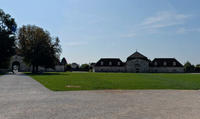You are in: Europe -> France -> Royal Saltworks of A... , and traditional search or Image Gallery will yield results of this site only
Royal Saltworks of Arc-et-Senans
| Site number: | 203 |
|
| Type of site: | Cultural | |
| Date: | 1775 | |
| Date of Inscription: | 1982 | |
| Location: | Europe, France, Franche-Comté Region, Département of Doubs | |
| Video: |
|
Up to 75 images are shown here. Click on each for more details or on Image Gallery for more images.
| Description: | Claude-Nicolas Ledoux chose an area near Besançon to build the Royal Saltworks of Arc-et-Senans. With construction beginning in 1775 during the reign of Louis XVI, the site was the first major accomplishment of industrial architecture, thus manifesting the ideal of progress of the Enlightenment. This immense, crescent complex was initially designed to allow a balanced and hierarchical organization of work and though never carried out it was originally meant to be followed by the building of an ideal city. --WHMNet paraphrase from the description at WHC Site, where additional information is available. For 360 degree imaging of this site, click here. | |
| The Saline Royale (Royal Saltworks) at Arc-et-Senans, in the forest of Chaux near Besançon, France is notable as an early Enlightenment architectural project to rationalize industrial buildings and processes according to a philosophical order. The saltworks' buildings were designed by architect Claude-Nicolas Ledoux. Construction began in 1775 during the reign of Louis XVI. The semicircular complex was planned to reflect a hierarchical organization of work. It was to have been enlarged with the building of an ideal city, but that project was never constructed. It is worth noting that the gabelle tax was a mandatory payment on all people over the age of 8 years to buy an amount of salt per year at a price fixed by the government. This was very unpopular and is quoted as one of the reasons of the French revolution. This probably explains why this building is so grand (funded by a state monopoly). The ideal city was probably curtailed by the French revolution. The site is preserved and managed as a monument by the Institut Claude-Nicolas Ledoux. It was added to the List of World Heritage Sites by UNESCO in 1982. --Wikipedia. Text is available under the Creative Commons Attribution-ShareAlike License. For 360 degree imaging of this site, click here. | ||
| Source: | http://whc.unesco.org/en/list/203 | |
| Source2: | http://whc.unesco.org/en/list/203/video | |
| Reference: | 1. UNESCO World Heritage Center, Site Page. | |


 NHK World Heritage 100 series
NHK World Heritage 100 series


































































